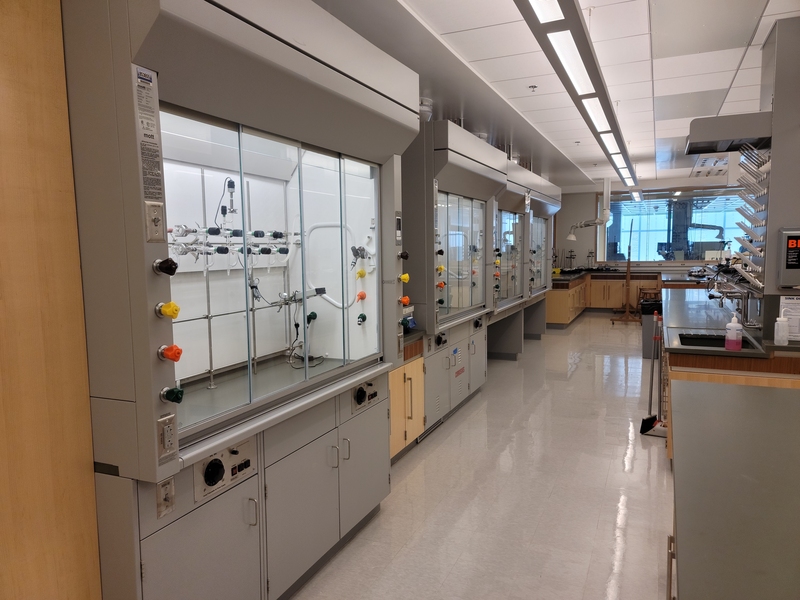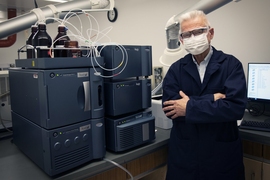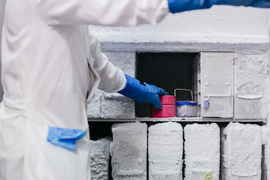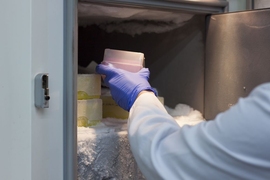The Department of Chemistry’s state-of-the-art Undergraduate Teaching Lab (UGTL), which opened on the fifth floor of MIT.nano in fall 2018, is home to 69 fume hoods. The hoods, ranging from four to seven feet wide, protect students and staff from potential exposure to hazardous materials while working in the lab. Fume hoods represent a tremendous energy consumption on the MIT campus; in addition to the energy required to operate them, the air that replaces what is exhausted must be heated or cooled. Thus, any lab with a large number of fume hoods is destined to be faced with high operational energy cost.
“When the UGTL’s fume hoods are in use, the air-change rates — the number of times fresh air is exchanged in the space in a given time frame — averages between 25 and 30 air changes per hour (ACH),” says Nicole Imbergamo, senior sustainability project manager in MIT Campus Construction. “When the lab is unoccupied, that air-change rate averages 11 ACH. For context, in a laboratory with a single fume hood, typically MIT’s EHS [Environment, Health, and Safety] department would require six ACH when occupied and four ACH when unoccupied. Hibernation of the fume hoods allowed us to close the gap between the current unoccupied air-change rate and what is typical on campus in a non-teaching lab environment.”
Fifty-eight of the 69 fume hoods in the UGTL are consistently unused between the hours of 6:30 p.m. and 12 p.m., as well as all weekend long, totaling 135 hours per week. Based on these numbers, the team determined it was safe to “hibernate” the fume hoods during the off hours, saving the Institute on fan energy and the cost of heating and cooling the air that gets flushed into each hood.
John Dolhun PhD ’73 is the director of the UGTL. “The project started when MIT Green Labs — a division of the Environment, Health, and Safety Office now known as the Safe & Sustainable Labs Program — contacted the UGTL in October 2018, followed by an initial meeting in November 2018 with all the key players, including Safe and Sustainable Labs, the EHS Office, the Department of Facilities, and the Department of Chemistry,” says Dolhun. “It was during these initial discussions that the UGTL recognized this was something we had to do. The project was completed in April 2021.”
Now, through a scheduled time clock in the Building Management System (BMS), the 58 fume hoods are flipped into hibernation mode at the end of each day. “In hibernation mode, the exhaust air valves go to their minimum airflow, which is lower than a fume hood minimum required when in use,” says Imbergamo. “As a safety feature, if the sash of a fume hood is opened while it is in standby mode, the valve and hood are automatically released from hibernation until the next scheduled time.” The BMS allows Dolhun and all with access to instantly view the hibernation status of every hood online, at any time, from any location. As an additional safety measure, the lab is equipped with an emergency kill switch that, when activated, instantly takes all 58 fume hoods out of hibernation, increasing the air changes per hour by about 37 percent, at one touch.
The MIT operations team worked with the building controls vendor to create graphics that allow the UGTL users to easily see the hood sash positions and their current status as either hibernated or in normal operating mode. This virtual visibility allows the UGTL team to confirm the hoods are all closed before leaving the lab at the end of each day, and to confirm the energy reductions. This visual access also lends itself to educating the students on the importance of closing the sash at the end of their lab work, and gives an opportunity for educating the students on relevant fume hood management best practices that will serve them far beyond their undergraduate chemistry classes.
Since employing the use of hibernation mode, the unoccupied UGTL air change rate has plummeted from 11 ACH to seven ACH, drastically shrinking unnecessary energy outflow, saving MIT an estimated $21,000 per year. The annual utility cost savings of both reduced supply and exhaust fan energy, as well as the heating and cooling required of the supply air to the space, will result in a less-than three-year payback for MIT. The overall success of the hood hibernation program, and the savings that it has afforded the UGTL, is very motivational for the Green Initiative. The highlights of this system will be shared with other labs, both at MIT and beyond, that may also benefit from similar adjustments.










